

Introducing Patents into a Major Service IndustryBy Mark Nowotarski, Les Nouvelles, March 2003 AbstractThe value of US patents for global service companies is increasing. The electronics manufacturing services (EMS) industry, in particular, is poised to substantially increase its patent activity. This is driven by new patent-intensive competitors, new laws in the form of business method patents and a new economic crisis forcing a need to expand and modify their basic business model. The EMS industry is adapting to patents by strategic planning, training employees, and tracking competitive patent activity. Sanmina-SCI is a major EMS company that recently adapted their business model to patent ownership and launched a significant patenting and licensing effort. 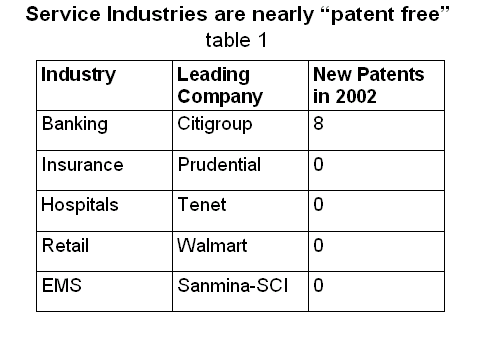
IntroductionService companies don’t normally need patents. Table 1 [i] illustrates several major service industries, major companies within those industries and the total number of new patents these companies obtained in 2002. With the exception of Citigroup, none of these companies obtained any patents. This is to be expected. Service companies sell the services of their employees. They do not sell products that are subject to reverse engineering and copying. Copying is what patents primarily protect against. The inventions of a service company are related to improving the efficiency of their operations. This often involves the customization of off-of-the-shelf technology, such as software and computer systems, for their particular needs. Customization acts as an effective barrier to copying. The direct copying of a competitor’s customized in-house solution would be difficult due to its secrecy. It would be of little value because it would have to be recustomized to the copier’s needs. Hence patents offer little additional value in protection against copying of service industry inventions. There are, however, service industries that are undergoing a rapid increase in their patent activity. This is being brought about by three major market forces 1) new competitors 2) new law and 3) new economic crisis. Any one of these forces can substantially increase the value of patents. The Electronics Manufacturing Services (EMS) industry is facing all three of these market forces. As a consequence, this industry is reevaluating its need for patents. 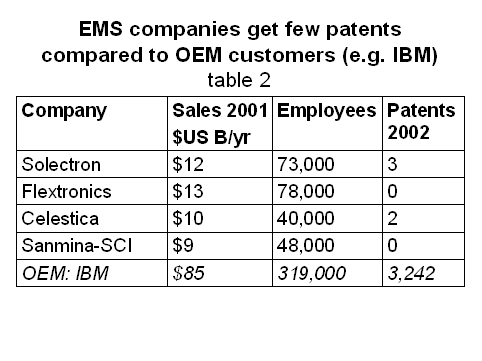

EMS IndustryThe electronics manufacturing services industry is a $100 billion per year global enterprise dedicated to efficient, high quality, low cost manufacturing of electronic assemblies. The major companies in this industry have revenues of about $US 10 billion/yr and employees in the range of 40,000 to 80,000 (Table 2) [ii] These companies have global manufacturing capabilities. Sanmina-SCI, for example, has 43 EMS manufacturing locations in 21 countries (figure 1) [iii] Other EMS companies are similarly distributed. For over 15 years the EMS industry grew at a steady rate of 20% per year. The primary drivers of their growth was the need for major OEMs (Original Equipment Manufacturers) such as IBM, HP, Philips, Motorola etc, to divest themselves of their manufacturing facilities in order to free up capital for investment into new product development. The primary enabler of their growth has been the “near commoditization” of the manufacturing process for electronic assemblies (i.e. soldering components and circuit boards together). Once the EMS companies demonstrated that they could manufacture as well and as cost effectively as the OEMs [iv] and the OEMs were comfortable that they had a choice of comparable high quality suppliers, there was no need for the OEMs to maintain their manufacturing capability. OEMs, particularly in the computer and telecommunications industries, sold off their manufacturing plants to the EMS companies. During the 1990’s, top EMS companies were growing at over 40% per year due in large part to the acquisition of these manufacturing facilities. EMS companies, by definition, don’t own the intellectual property for the products they build. Patent activity in EMS companies is very low compared to their OEM customers (table 2). Nonetheless, the EMS industry is a technology intensive industry employing tens of thousands of engineers, programmers and other innovative technical personnel. Their inventions are in the area of global technical communications, just-in-time manufacturing, cash flow management and inventory control. Innovations in all of these areas can be protected by patents. The value of patents for EMS companies, however, is growing due to new competitors, new laws and new economic crisis. The new competitors are the Original Design Manufacturers (ODM). The new law is the recent State Street bank decision affirming the validity of US business method patents. The new economic crisis is the sustained downturn in both the telecommunications market and the computer market. 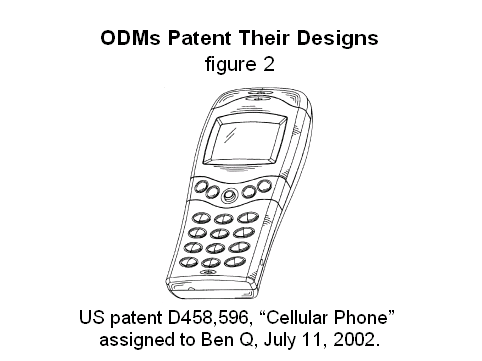
New Competitors: the ODM IndustryOriginal Design Manufacturers are a new form of competitor for EMS companies. Original Design Manufacturers are similar to EMS companies, except that, in addition to providing manufacturing services, they also provide completely designed products. These designed and manufactured products are referred to as “white box” products. OEMs purchase white box products and put their brand on them. It is an effective strategy for products such as cell phones (figure 2) and personal computers where both the product and the manufacturing process have become a near commodity. By outsourcing design as well as manufacturing, OEMs can focus their resources on brand building and marketing. Until recently, ODM companies and EMS companies did not normally compete. The smaller ODMs could not match the larger EMSs in their economies of scale in manufacturing. The EMS companies, on the other hand, had no desire to develop their own products. They did not want to run the risk of being seen as competitors by their OEM customers. This non-competition was erased in July of 2001. An article in Electronic Business News announced: “Last month, Dell Computer handed Compal and Quanta (two major ODMs) its low-end notebook business, which was originally slated for Jabil Circuit Inc., a St. Petersburg Fla. EMS provider” [v] The EMS response was swift. In less than a year, all of the major EMS companies had announced their own product design offerings. This has been described as “a move that ultimately may demand that the contract manufacturing industry (i.e. EMS) surmount its biggest challenge yet.” [vi] 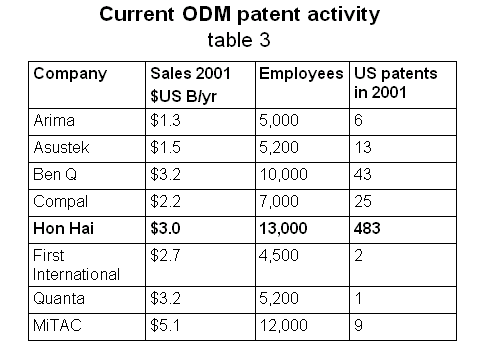
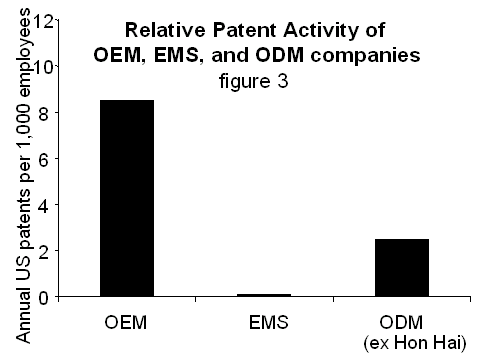
ODMs protect their designs with patents (figure 2). Table 3 [vii] lists several major ODM companies, their sales figures, their number of employees and the number of US patents they each obtained in 2002. The relative patent activity of OEM, EMS and ODM companies is illustrated in figure 3. On a per-employee basis, ODM companies are producing patents at over 100 times the rate of their EMS counterparts. They are even gaining on the patenting rate of their OEM customers. 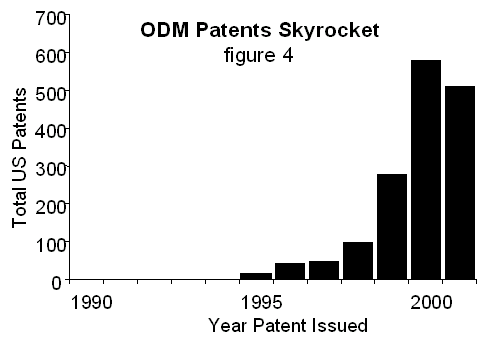
The ODM industry has only embraced patents in the past five years. Figure 4 shows the skyrocketing growth in ODM patent activity since 1995. This growth is another example of how new competition, new laws and/or new economic crisis can increase the value of patents. ODM companies are all based in Taiwan. The new competitive force that acted upon them was the proactive assertion of US patent rights by US patent holders to block the importation of products made by US patented manufacturing processes. Hon Hai, for example was sued by AMP in 1996 to block the importation of electrical connectors [viii]. As part of the judgment, Hon Hai had to pay a substantial fee for every covered connector it exported to the US. Hon Hai immediately began ramping up its patent production rate and now has a per-employee patent activity is over three times that of perennial patent champion, IBM. Their patents are one half the size (8 pages on average vs 16 pages) but they issue twice as quickly (18 months on average vs 36 months) as IBM’s. 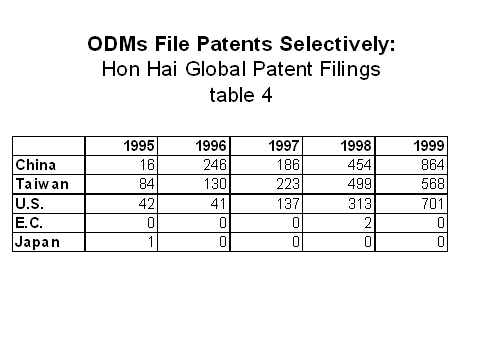
Hon Hai is very selective where they file their patents (table 4) [ix] . They file in Taiwan where they are based, China where they are expanding manufacturing operations, and the US where they are developing a cross licensing portfolio. They almost never file in Europe or Japan. With their new patent portfolios, they have been able to bring their own defensive infringement actions. As their chairman, Terry Gou recently put it, “Patent is the rule of the game in new times. To survive in the economic times, manufacturers have to abide by the new rule” [x]. 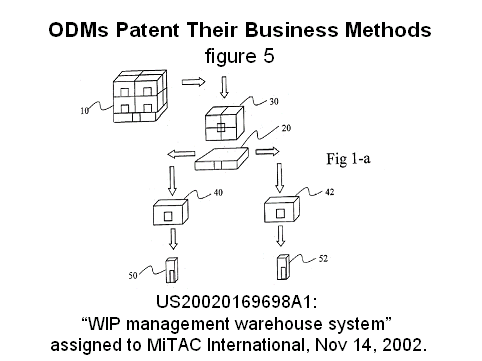
New Law: Business Method patentsThe recent interpretation of US patent law by the US Court of Appeals for the Federal Circuit has held that a pure algorithm, even for a new method of doing business, is patentable subject matter provided it can be applied “in a new an useful way” [xi] . For manufacturing companies, this means that inventions in core competencies such as inventory control, cash flow management, and inter/intra company communications can now be protected with patents. Those that don’t develop patent portfolios in their core competencies run the risk of having their business operations constrained by those that do. ODM’s are protecting their business methods as well as their product designs with US patents (figure 5). They, along with their counterparts in the semiconductor foundry industry, have fully embraced business method patents. EMS companies have also begun to protect their business method inventions with patents. Solectron recently had four US patents issue that covered an improved email routing system [xii]. The patents cover a broad range of applications related to the hand-off of emails in a chain of command. The most successful application to date is for approving “engineering change modifications”. For Vince DePalma, VP of technology, “These patents are a beginning for us. We have a major effort in both internal and external communications technology. We want to make sure we maintain our leadership in this area” [xiii] New Crisis: Telecom/Computer downturn2001 and 2002 have been very difficult years in the EMS industry. Slumping demand in the telecommunications and computer industry have led to the EMS industry’s first-ever years of negative growth [xiv]. Patent intensive ODM companies, on the other hand, have maintained their growth at 10% per year. As part of their response, EMS companies are now making the transition to owning and protecting their intellectual property with patents. An EMS company obtains value from patentsSolectron-SCI has recently incorporated patents into their EMS business model [xv]. They made this move when they obtained a valuable, patented, printed circuit board manufacturing process, Buried Capacitance™, in a recent merger [xvi]. They established the “Sanmina-SCI Licensing and Intellectual Property Group” (SLIP) to license this and other related technologies that they were developing. The SLIP group is headed by George Dudnikov, Sr. Vice President and Chief Technology Officer of the PCB division. They have implemented three key steps as part of their program, 1) strategic planning 2) training of employees and 3) monitoring of competitive patent activity. Sanmina-SCI evaluates its licensing strategy on a case-by-case basis. It has found that a broad, non-exclusive licensing strategy can be very effective at accelerating controlled dissemination of their technology. This generates both licensing revenue as well as new demand for their related circuit board business. Their licensing package may include technical support, training, and access to improvements. Direct competitors may be licensed including those in China. “We are pleased with the results of our decision to license competitors, including those in China”, says George, “Our customers are getting a choice of qualified suppliers and we are seeing continued growth in the total market for our high performance products.” Basic patent training is provided to business leaders, technologists and even customers. The training of customers is particularly important since patent ownership and enforcement by a manufacturing services company is relatively new to the industry. Technologists are given training in how to write an effective invention disclosure. An invention disclosure contains the information that a patent attorney or agent needs to prepare a patent application. Preparation of a patent application can cost from $7,000 to $20,000. A well-written and complete invention disclosure can cut that cost in half. Competitive patent tracking is done using government on-line databases (e. g. www.uspto.gov) and private on-line databases (e.g. www.micropatent.com). Patents and patent applications of interest are routed to appropriate business, technical and legal personnel. Appropriate action is then taken. Sanmina-SCI’s licensing program has been quite successful. Buried Capacitance has been licensed to 25 companies around the world and is becoming the preferred technology for high-speed circuit boards. Perhaps more importantly, Sanmina-SCI now has a successful model for incorporating patents into other segments of their EMS business. ConclusionNew competitors, new law and new economic crisis are increasing the value of patents to service industries. Electronic Manufacturing Services is an example of an industry that will substantially increase its patent and licensing activity due to new patent-intensive ODM competitors, new law in the form of business method patents and the new economic crisis due to the downturn in the telecommunications and computer markets. Sanmina-SCI is an example of an EMS company that is capturing the value of patents by strategic planning, training of employees and tracking competitive patent activity. Need to learn more about ODMs or patents? Click here to ask a follow up question. [i] All patent statistics from www.uspto.gov or www.delphion.com. Some patent figures may be low due to assignment of patents to subsidiaries instead of to the parent. [ii] Company sales and employment statistics are from www.hoovers.com, www.sec.gov, and company publications unless otherwise noted. [iii] www.sanmina.com/Info/locations/glob_loc.jsp [iv] Solectron, for example, has twice won the US “Malcolm Baldrige” quality award. [v] Serant, C., “Taiwan design firms pose competition for EMS providers”, Electronic Business News, August 17, 2001. [vi] Serant, C. “EMS industry sees haven in new-product design”, Electronic Business News, October 4, 2002. [vii] Most data from “ODM and EMS Markets Begin to Overlap”, Manufacturing Market Insider, JBT Communications, Needham MA USA, August 2002, from company specific web sites. [viii] United States International Trade Commission, “In the Matter of Certain Electrical Connectors and Products Containing Same”, Inv. No. 337-TA-374, May 13, 1996. [ix] www.foxconn.com/about/innovation.asp [x] Interview with Terry Gou, Economics Daily, July 11, 2001. [xi] Rich, US Court of Appeals for the Federal Circuit, “State Street Bank & Trust vs Signature Financial Group”, No 96-1327, July 23, 1998. [xii] US patent 5,978,836, "Workflow Systems and Methods" and related divisionals and continuations-in-part. [xiii] Nowotarski, M, “Obtaining Value from Patents in Electronics Manufacturing Services”, Circuits Assembly Magazine, on line addition, January 2003, www.circuitsassembly.com. [xiv] “PTC Sponsors Technology Forecasters’ Quarterly Forum for Electronics Manufacturers Outsourcing Supply Chain”, September 19, 2002. www.techforecasters.com. [xv] Ibid. Nowotarski, M. [xvi] http://www.sanmina.com/Info/PR/2000_archive/pr04_17_00.html Click here to send comments or ask follow-up questions. © 2007 Markets, Patents & Alliances, LLC |
CROWDFUNDINGDo you know a high-quality, low-volume
|